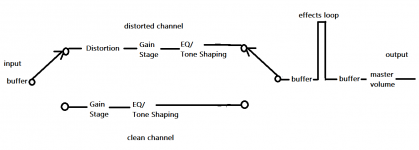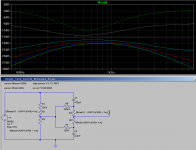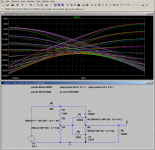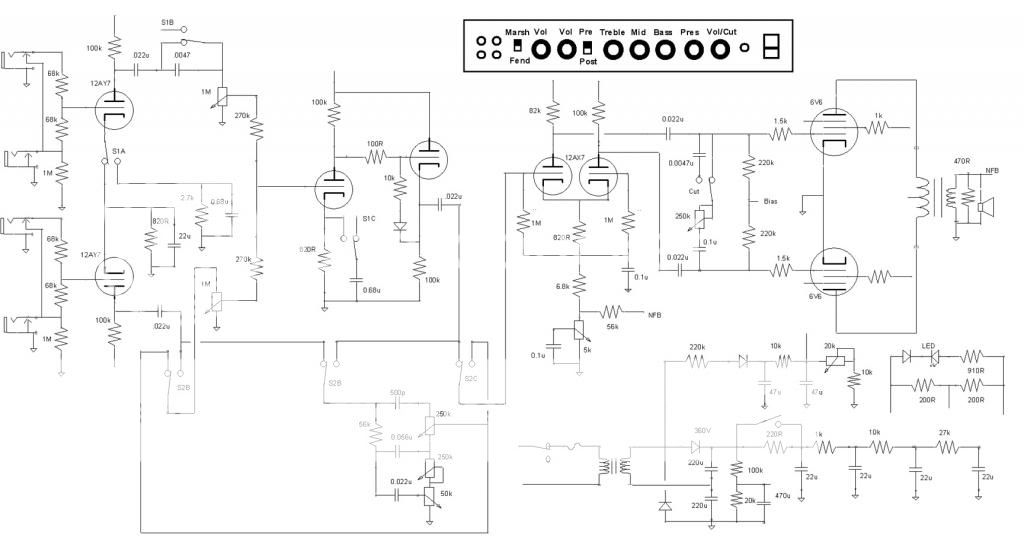Hi there, thanks for looking. I am building a guitar preamp and I was wondering if the EQ/toneshaping goes before or after signal a gain stage. I'm not talking about gain in the sense of gain control on distortion. I'm just talking about boosting the signal.
The tones shaping/EQ section was going to be passive, so I was thinking you would first take the guitar signal, boost it, then to the passive tone shaping.
If I first ran the signal into passive tone shaping first , I was thinking there would be some signal loss, (by definition since its passive), then having "make-up gain" after this would give more noise, (lower signal to noise ratio).
Do I have this right? I have included a rough sketch of how I was going to lay things out in the schematic. Assume that all the stages are built so that impedance matching is not an issue, I will design the stages that way.
The tones shaping/EQ section was going to be passive, so I was thinking you would first take the guitar signal, boost it, then to the passive tone shaping.
If I first ran the signal into passive tone shaping first , I was thinking there would be some signal loss, (by definition since its passive), then having "make-up gain" after this would give more noise, (lower signal to noise ratio).
Do I have this right? I have included a rough sketch of how I was going to lay things out in the schematic. Assume that all the stages are built so that impedance matching is not an issue, I will design the stages that way.
Attachments
Help or advice on best signal chain for bass, mid and treble filters
Hi, I was wondering in general, if I were to build a tone control with bass, mid and treble in a sequential fashion, what would be the best order to put the controls in. I was going to use passive controls.
I was thinking bass cut first, then treble cut, then mid cut. Is there a best order or does it really matter?
Assume the stages would be impedance matched or buffered appropriately.
Hi, I was wondering in general, if I were to build a tone control with bass, mid and treble in a sequential fashion, what would be the best order to put the controls in. I was going to use passive controls.
I was thinking bass cut first, then treble cut, then mid cut. Is there a best order or does it really matter?
Assume the stages would be impedance matched or buffered appropriately.
I was going to use passive controls.
I was thinking bass cut first, then treble cut, then mid cut.
Usually they're in parallel.
http://1.bp.blogspot.com/_S6OPCTq1K...200-h630-p-k-no-nu/Passive_Tone_Control_1.jpg
Otherwise, high filtering first would give more headroom in the buffers.
> Do I have this right?
So far as you write, yes.
But the drawing shows gain after distortion. Most distortion schemes make BIG output, but need gain *before* (or included) to do the big dirt. Gain after distortion is rarely needed.
But plagiarize plagiarize plagiarize ! You are not the first down this trail. Study ALL the schematics you can find. There are many variations, sometimes for no good reason; it may come down to stealing one you know works good and adapting it.
So far as you write, yes.
But the drawing shows gain after distortion. Most distortion schemes make BIG output, but need gain *before* (or included) to do the big dirt. Gain after distortion is rarely needed.
But plagiarize plagiarize plagiarize ! You are not the first down this trail. Study ALL the schematics you can find. There are many variations, sometimes for no good reason; it may come down to stealing one you know works good and adapting it.
It is not a good idea to connect them in series especially for passive networks, you will have big amount of attenuation there. Why not try this active type:
3 band tone control design – tataylino.com
3 band tone control design – tataylino.com
When your circuit behaves linear, then it doesn't matter where you put the EQ.
But when it behaves non-linear, it matters a lot, a whole lot.
In practice guitar amp distortion stages have high pass filters just before them or build in. In tube circuits that could be the cathode bypass cap having a small value, and its worth experimenting with these values to suit your taste.
This is an interesting read on build-in EQ of distortion circuits: The Technology of the Tube Screamer
Most amps follow this: Signal - high pass filter - distortion - EQ - output.
When producing music I always EQ before and after distortion, that gives the most control.
But when it behaves non-linear, it matters a lot, a whole lot.
In practice guitar amp distortion stages have high pass filters just before them or build in. In tube circuits that could be the cathode bypass cap having a small value, and its worth experimenting with these values to suit your taste.
This is an interesting read on build-in EQ of distortion circuits: The Technology of the Tube Screamer
Most amps follow this: Signal - high pass filter - distortion - EQ - output.
When producing music I always EQ before and after distortion, that gives the most control.
+1 this. You're doing it any way, so do it consciouslyWhen producing music I always EQ before and after distortion, that gives the most control.
It is best not to use passive controls. <snip>
As I found out a few years ago, passive tone controls are almost universally used in (valve) guitar amps. At first, this seemed bizarrely primitive to me, considering how poorly these tone controls work, and also considering that "Baxandall's bass and treble circuit, when made public in Wireless World (1952), 'swept all others before it', as Wikipedia puts it. Nineteen fifty-two was a long time ago!Why not try this active type: <snip>
But on reflection, it turns out that there are some good reasons for using these primitive and lossy passive tone controls, all hinging on one key concept unique to guitar amps: overdrive, deliberately overloading one or more gain stages until they clip, and clip severely.
Think for a second about that lovely 1952 active Baxandall tone control circuit. What happens if you overdrive it, and cause the output to clip?
Well, once into clipping, the output signal gets clamped at a more or less constant voltage. This causes the negative feedback signal to no longer track the input signal. Essentially, all negative feedback disappears.
And when that happens, so does the "tone control" action, which functions only because of those frequency-dependent negative feedback networks Baxandall designed.
Worse, the removal of negative feedback unleashes most or all of the open-loop gain around the signal zero-crossings; the result is extremely harsh and abrupt overdrive.
So reason number one to avoid active tone controls in a guitar amp is that you cannot overdrive them at all, otherwise they stop working as tone controls, and simultaneously create unpleasantly harsh distortion. And this must hold true even at the most extreme tone control settings.
It is possible to do this - you have to put a large amount of signal attenuation between the previous (valve) stage, and the input of the active tone control, so that even when the preceding valve is heavily overdriven, the signal to the active tone control is sufficiently small, to prevent it from ever being overdriven itself.
But what we've now been forced to do is attenuate the heck out of the signal - exactly one of the biggest failings of passive tone controls, and we've been forced to introduce it into our design because we were trying to use a superior active tone control!
There is a second reason why passive tone controls are preferred in guitar amps. This is simply that, when overdriven, valve stages put out very large-amplitude signals - hundreds of volts, peak-to-peak. Often we want to follow this overdriven stage with another valve gain stage, but that stage can only accept a few volts peak-to-peak at its input. Certainly not hundreds of volts.
So we have too much signal, and need to attenuate it heavily before we feed it to the second stage. As long as we have to attenuate the signal, why not use a passive tone control circuit to do the job? We get the attenuation we need, and, as a bonus, get the tone controls that we also need.
Once I realized these things, my focus shifted away from introducing active tone controls into my own guitar amp circuit designs. Instead, I started to look for a better passive tone control design, something nearly as good as that lovely active Baxandall, if possible.
After lots of reading and LTSpice simulations, I started with the Voight tone control circuit from Merlin Blencowe's guitar preamp design book, and tweaked it until it gave me something very close to what I was looking for: very little interaction between bass and treble controls, smooth and relatively linear EQ changes with potentiometer rotation, and a nearly perfectly flat setting somewhere in the middle. See attachments for some of my results.
The second image shows that there is some interaction between controls, but it is quite slight compared to the awful "Fender-Marshall-Vox tone stack" that has been so wildly popular for sixty-odd years.
The second of the two attached circuits has been built and is in use in one of my guitar amp designs. I haven't measured the frequency response curves to confirm that it matches the LTSpice simulations, but my ears and brain say that it works well. It is now my favourite guitar amp tone control circuit.
(Note that the apparently obvious solution - the "passive Baxandall" - did not work well at all in my simulations. EQ boost and cut curves were lopsided and wildly assymmetrical, both with log and linear pots.)
-Gnobuddy
Attachments
Thanks Gnobuddy and everyone else for the great comments. I think I probably wasn't super clear about the gain and EQ though. I really was getting at distortion per say when I said gain. I was more talking about a clean preamp.
1) Guitar-> buffer-> gain stage of ~3 -> passive tone control -> to power amp
2) Guitar-> buffer-> passive tone control -> make up gain ~3 -> to power amp
As far as the best order for tone controls, as has been mentioned there are a lot of parallel circuitry.
But in the preamp I am currently working on I was thinking roll of bass during and initial stage (bass control), treble roll off (treble control), and mid cut (bridge-t) style. Its sort of easy to incorporate simple tone controls between stages.
You can always have a small capacitor before a stage that you can bypass with a potentiometer for a bass control. You use the next stages input impedance in the RC calculation formula.
You can always place a treble capacitor to ground in series with a potentiometer for a treble control. You have to use the output impedance of the preceding stage in the RC calculation formula.
You can always sandwich a bridged-T filter between stages if impedance matching permits, with a potentiometer to ground.
You can also parallel an inductor in series with a potentiometer as a mid control to ground. In the RLC circuit you use the preceding stages output impedance in the RLC frequency formula and the width can be controlled by keeping the product of LxC the same and raising or lowering L and C.
So really I see that most guitar preamps/amps use all tone controls at once typically, but it seems multistage designs lend themselves easily to individual controls.
In practice I have typically rolled off bass first, then treble, then final mid control, but a few times I did bass control, then mid cut, then treble at end. Just my own meandering experience.
Taytalino asked why not go active (thank you for the circuit you posted). Gnobuddy's explanation is much more elegant than mine. My reasoning was just simplicity, if it seems to work well enough.
1) Guitar-> buffer-> gain stage of ~3 -> passive tone control -> to power amp
2) Guitar-> buffer-> passive tone control -> make up gain ~3 -> to power amp
As far as the best order for tone controls, as has been mentioned there are a lot of parallel circuitry.
But in the preamp I am currently working on I was thinking roll of bass during and initial stage (bass control), treble roll off (treble control), and mid cut (bridge-t) style. Its sort of easy to incorporate simple tone controls between stages.
You can always have a small capacitor before a stage that you can bypass with a potentiometer for a bass control. You use the next stages input impedance in the RC calculation formula.
You can always place a treble capacitor to ground in series with a potentiometer for a treble control. You have to use the output impedance of the preceding stage in the RC calculation formula.
You can always sandwich a bridged-T filter between stages if impedance matching permits, with a potentiometer to ground.
You can also parallel an inductor in series with a potentiometer as a mid control to ground. In the RLC circuit you use the preceding stages output impedance in the RLC frequency formula and the width can be controlled by keeping the product of LxC the same and raising or lowering L and C.
So really I see that most guitar preamps/amps use all tone controls at once typically, but it seems multistage designs lend themselves easily to individual controls.
In practice I have typically rolled off bass first, then treble, then final mid control, but a few times I did bass control, then mid cut, then treble at end. Just my own meandering experience.
Taytalino asked why not go active (thank you for the circuit you posted). Gnobuddy's explanation is much more elegant than mine. My reasoning was just simplicity, if it seems to work well enough.
If the preamp is truly clean, then it doesn't matter what order you have the various sub-circuits of your tone control in. There is a very elegant mathematical concept called "linear superposition" which electronic engineers learn, and which proves this.I was more talking about a clean preamp.
But once you introduce overdrive, Aqua Tarkus' advice is the way to go. Linear superposition does not apply during (nonlinear) overdrive! So attenuate bass before overdrive, otherwise you'll have a muffled and woofy-sounding amp.
-Gnobuddy
Thanks everyone! Thanks Gnobuddy. I am going to look up "linear superposition" and read more.
My clean signal chain is basically going to be:
buffer - toneshaping - make up gain - buffer - power amp
(or I may sandwhich some filters between the stages, still debating)
Distorted section will be:
buffer - bass rolloff/distortion section - tonestack - make up gain - buffer - power amp
I will post a schematic after I finish, which will be a while because I'm still perfecting the distorted section.
I'm switching gears so to speak to the distorted section of the preamp, I've also been working on the distortion section, I looked at the Boss Ds-1, which I kind of liked in general. I thought it was interesting that it has a high gain transistor stage followed by an op amp with a gain of 22. Seems opposite to me I thought the op amp was more suited to a high gain application and transistor to lower gain.
So I built the boss ds-1 but replaced the op amp section with a transistor section and it seems to work fine. I'm getting nearly identical waveforms in simulations and also nearly identical bode plot. If anyone is interested I can post but I've just replaced the op amp gain 22 with transistor gain 22.
My clean signal chain is basically going to be:
buffer - toneshaping - make up gain - buffer - power amp
(or I may sandwhich some filters between the stages, still debating)
Distorted section will be:
buffer - bass rolloff/distortion section - tonestack - make up gain - buffer - power amp
I will post a schematic after I finish, which will be a while because I'm still perfecting the distorted section.
I'm switching gears so to speak to the distorted section of the preamp, I've also been working on the distortion section, I looked at the Boss Ds-1, which I kind of liked in general. I thought it was interesting that it has a high gain transistor stage followed by an op amp with a gain of 22. Seems opposite to me I thought the op amp was more suited to a high gain application and transistor to lower gain.
So I built the boss ds-1 but replaced the op amp section with a transistor section and it seems to work fine. I'm getting nearly identical waveforms in simulations and also nearly identical bode plot. If anyone is interested I can post but I've just replaced the op amp gain 22 with transistor gain 22.
My clean signal chain is basically going to be:
buffer - toneshaping - make up gain - buffer - power amp
(or I may sandwhich some filters between the stages, still debating)
Distorted section will be:
buffer - bass rolloff/distortion section - tonestack - make up gain - buffer - power amp
If your power amp is push-pull, you could use a long-tailed pair PI as the make up gain & buffer combined.
The basic concept is quite simple - for instance, if you run three different sinewaves (at three different frequencies) into a linear amp, then the output is still those same three sinewaves; no new frequencies are generated.I am going to look up "linear superposition" and read more.
This also means that if you put, say, bass cut before treble cut, or switch the order around, it makes no difference; those three different sinewaves remain independent of each other all the way through the (linear) amp. Doesn't matter if you cut or boost one before the other.
But if you run those three different sinewaves into a nonlinear device - an overdriven amp, or a clipping diode, for example - then the output is no longer just the same three original sinewaves. We know about intermodulation distortion, for example - new frequencies get generated.
In the case of an overdriven guitar amp, the lower frequency bass signals from a guitar tend to be much larger than the higher frequency treble signals. When you run this combination of frequencies through an overdriven gain stage, the large bass signals tend to dominate the signal, and the smaller treble signals get squashed into oblivion.
So what comes out of the amp tends to sound like nicely distorted bass, but with very little treble to go with it. Muffled and woofy.
The time-tested way out of this is to cut the bass signals down to size, so they don't dominate the treble so much, before squashing the whole lot through an overdriven stage.
Which is sorta why the typical heavily overdriven guitar amp doesn't have all that much deep bass, and guitar amps that do have deep bass tend to be clean.
Sometimes the gain-bandwidth product of an opamp limits how much gain you can get out of it, and still have a wide enough frequency bandwidth. The (now antique) 741 opamp had a gain bandwidth product of 1 MHz, and a DC open-loop gain of 100,000. That enormous gain only went from DC up to 10 Hertz (not kilohertz) though!I thought the op amp was more suited to a high gain application and transistor to lower gain.
If you used negative feedback to cut the gain down to only 100, then you got a bandwidth of 10 kHz. Enough for guitar, maybe, just barely, but not for Hi-Fi. (The 741 wasn't suited to Hi-Fi in many other ways as well.)
So here was an opamp with a gain of 100,000, but for audio use, you had to keep gain down to 50 or 100 at most!
By the time the wonderful 5532 opamp came along, gain bandwidth product was up to 10 MHz. You could get a gain of 100,000 times up to 100 Hertz, or 1000 times up to 10 kHz. If you wanted a frequency response out to 40 kHz, say, you are still limited to a voltage gain of 250 times.
-Gnobuddy
In my experience, it's even worse than that, a mushy distorted mess, presumably due to intermodulation products.T
In the case of an overdriven guitar amp, the lower frequency bass signals from a guitar tend to be much larger than the higher frequency treble signals. When you run this combination of frequencies through an overdriven gain stage, the large bass signals tend to dominate the signal, and the smaller treble signals get squashed into oblivion.
So what comes out of the amp tends to sound like nicely distorted bass, but with very little treble to go with it. Muffled and woofy.
Just wondering ... i know there's probably more than one answer but wheres a typical roll off frequency for the bass before distorting the signal. My amalysis for the boss ds1 was 200-300hz. (I don't think electrosmash analysis got that right). Ive read as high as 700hz for some circuits
Without having the math, to hand, I tend to think the 200Hz/300Hz is quit adequate, However personal preference also comes in.If you like the sound of an AC30 Top Boost, that amplifier cuts an extreme amount of low end in its preamp, possibly cloer to you 700HzJust wondering ... i know there's probably more than one answer but wheres a typical roll off frequency for the bass before distorting the signal. My amalysis for the boss ds1 was 200-300hz. (I don't think electrosmash analysis got that right). Ive read as high as 700hz for some circuits
- Status
- This old topic is closed. If you want to reopen this topic, contact a moderator using the "Report Post" button.
- Home
- Live Sound
- Instruments and Amps
- signal chain in guitar preamp, boost before eq or eq before boost



